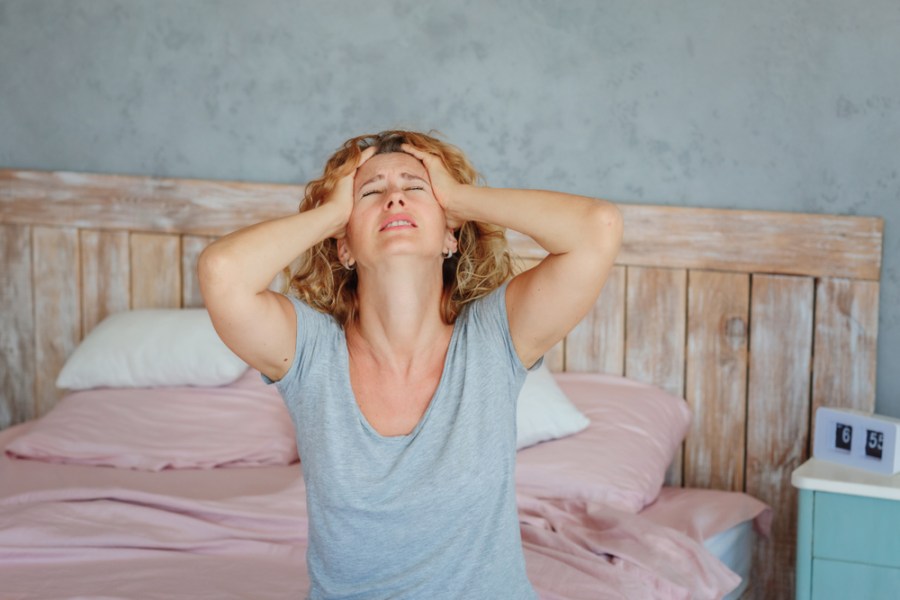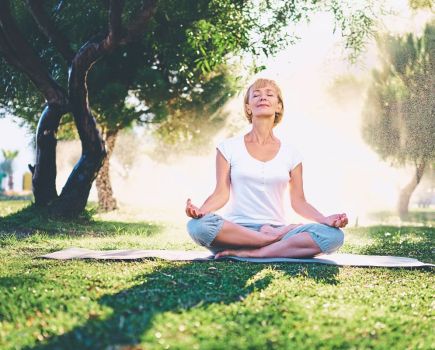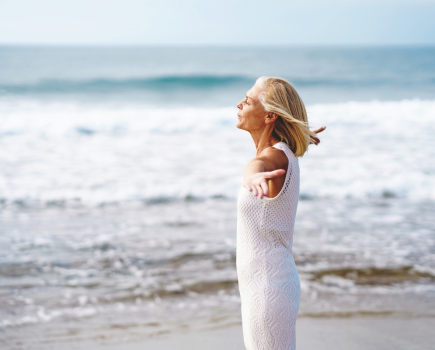Menopause night sweats can be troublesome during the best of times. However, during the ongoing heatwave, thousands of women have been left struggling to find relief. If you’re avoiding HRT, or you’re unable to get your prescription right now, try these natural remedies to encourage oestrogen and progesterone production to help reduce menopause night sweats without hormones, as well as lifestyle hacks to improve your sleep environment…
It’s always advisable to chat to your doctor before trying any natural remedies, supplements or superfoods to reduce menopause night sweats, so they can check on any potential side effects or interactions with other medications.
What helps with night sweats during menopause?
We’ve rounded up the best natural remedies to reduce menopause night sweats without the need for hormones…
1. Add soy to your diet
You can counteract the natural drop in oestrogen, which is linked to night sweats, by eating certain foods. ‘Soy is found in tofu, tempeh, edamame beans, miso and soy milk, and contains isoflavone compounds (a type of phytoestrogen) that have oestrogen-like properties,’ says Hope Bastine, psychologist and resident expert for Simba Sleep.
‘Researchers analysing 19 studies found soy isoflavone supplements reduced the severity of hot flushes by around 26 per cent, in contrast to a placebo. Although, it is worth noting it doesn’t have immediate results,’ she adds.
TOP TIP: Reduce or eliminate alcohol, caffeine, nicotine and spicy foods if you suffer from hot flushes, as all can make symptoms worse.
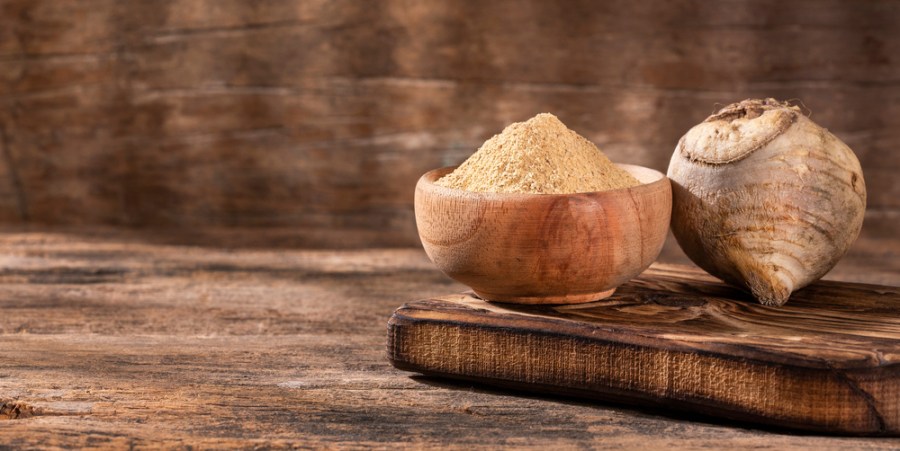
2. Try maca root
A cruciferous vegetable related to broccoli, cauliflower and kale, maca has been cultivated for thousands of years. Originating from and growing high in the South American Andes and mountainous provinces in China, maca has a nutty taste and scent similar to butterscotch and is also known as Peruvian ginseng, lepidium meyenii, and ginseng andin.
‘While more research is needed, a handful of studies have shown evidence that maca root may help to alleviate hot flushes and interrupted sleep thanks in part to its glucosinolates that stimulate the body to produce balanced levels of hormones,’ says Hope.
Best maca root supplement: Viridian Organic Maca Root 500mg (£14.45) contains all three known maca root colours. You can also find powdered maca to sprinkle on porridge or add to drinks.
3. How chasteberry reduces menopause night sweats
Another herbal remedy that may help soothe menopausal symptoms is chasteberry. Derived from chaste trees found in the Mediterranean and Asia, the berries are also known as vitex agnus castus or monk’s pepper. ‘Like maca, chasteberry contains no hormones. It’s an adaptogen, meaning it adapts to your body’s needs and helps it to naturally produce hormones,’ says Hope.
When you experience a fall in oestrogen levels, this can also be accompanied by a drop in progesterone, especially so at menopause. ‘Chasteberry works by acting on the pituitary gland and the hypothalamus, which are responsible for releasing hormones or triggering hormone responses. This indirectly increases progesterone production,’ says Hope.
A 2003 study showed improved mood and sleep when vitex oils were given to 23 women in menopause. A follow-up study the same year looked at 52 pre- and post-menopausal women who were given vitex cream: a third experienced major improvements and 36 per cent reported moderate relief from night sweats and hot flushes.
‘PMS symptoms have also been linked with a low level of progesterone relative to oestrogen, so chasteberry may also provide a helping hand for those in perimenopause, leading up to menopause, which usually begins in your mid-to-late 40s,’ says Hope.
How much chasteberry should I take?
In her book Keto-Green 16 (£16.99) Dr Anna Cabecca says clinical trials suggest a dose of 20-40mg a day of chasteberry extract, although some companies sell capsules containing 300mg. Fluid extract of 40 drops daily in the morning or a tincture of 35-45 drops three times daily have also been used, she says, but talk to your healthcare practitioner.
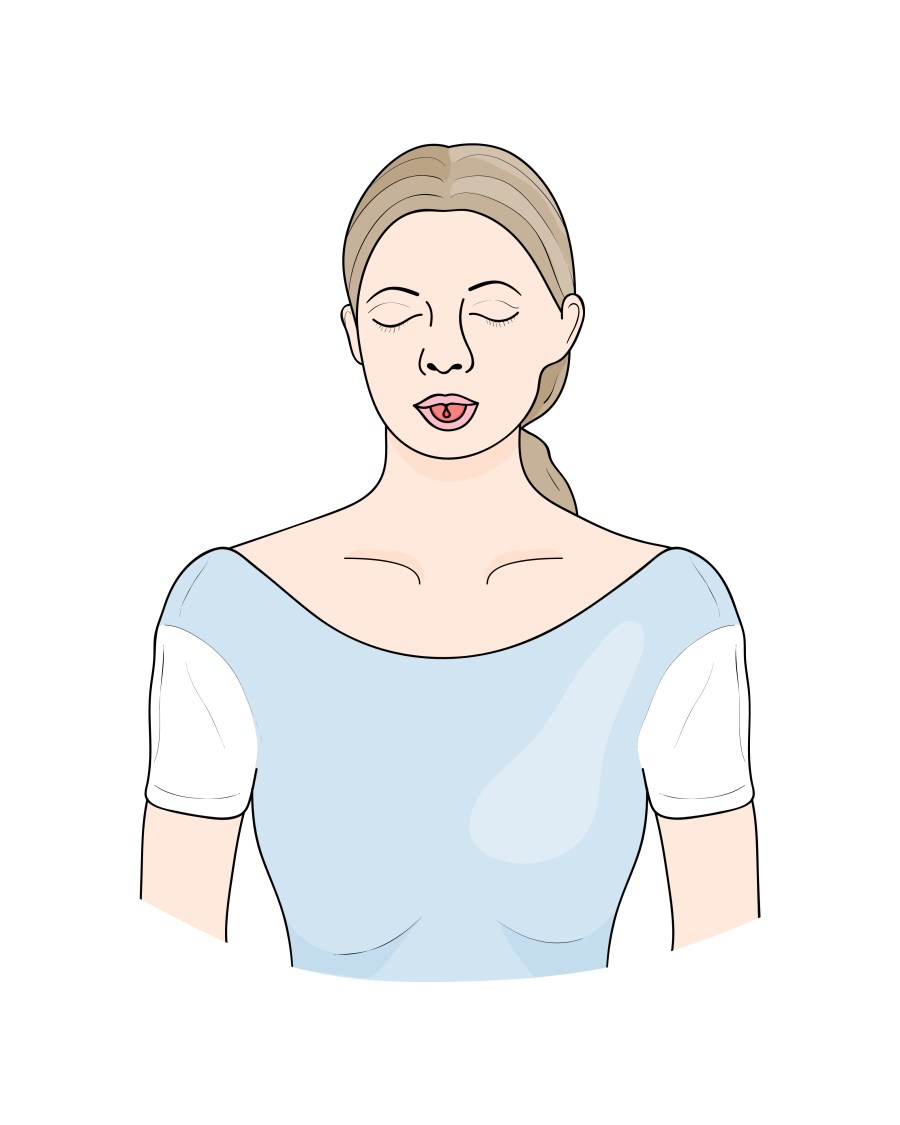
4. Snow breathing technique for menopause night sweats
Meditative techniques have been used for hundreds of years to regulate body temperature. ‘Sitali pranayama, or “snow meditation” as I like to refer to it, is a simple breathing technique designed to cool the body, adding moisture to your system,’ says Hope.
How to do snow breathing to naturally reduce menopause night sweats: ‘Start by popping your tongue out, then curl the sides inwards. Think of it like your tongue becoming a straw to drink in the air. Take a slow deep breath in for five seconds, taking time to feel the cool air refresh your throat and fill your lungs. Draw the tongue back in. Hold for a second, then exhale through your nose.’
Repeat up to 10 times and use throughout the day or night when you need a cooling breath.
5. Use CBT to prevent waking up at 4am
Sleep comes to you by way of the hormone melatonin, which tells your body it’s time to sleep. However, melatonin production capacity reduces as you get older, meaning if you wake in the wee hours, it can be difficult to fall back to sleep – particularly around 4am.
‘Research shows that mindfulness-based cognitive behavioural therapy (CBT) is effective in managing menopausal symptoms. It can be learned on a four- to eight-week course that combines the principles of mindfulness with practical tools of CBT to help you cope with this major life change,’ says Hope. Find out more online and at cbtplus.co.uk.
TRY IT: Reduce screen time at least an hour before bed, including smartphones and tablets, as the blue light emitted from them can switch off your melatonin production as your brain thinks it’s still daytime. This makes it more difficult to sleep when you do get into bed.
6. Try temperature regulating bedding for menopause night sweats
Night sweats, being too hot and tossing and turning are frustrating enough when they’re a one-off occurrence, but research shows they’re directly linked to hormonal changes. What you sleep on, and in, can massively help reduce hot flushes.
‘Anything that holds heat will just add fuel to the fire,’ says Hope. ‘It’s a good idea to have a mattress that allows for air flow, and use sheets, duvet and pillows that also help to regulate your heat.’ Remember, while memory foam pillows might feel nice and comfy, most of them retain heat so could make matters worse if you’re menopausal. You can also get cooling bedding that allows for better airflow and which wicks away moisture.
Best cooling bedding for menopause night sweats:
The Simba Hybrid Duvet (£199 for a double) helps regulate body temperature, keeping you cool during the summer months thanks to a special material that absorbs and then releases heat throughout the night, maintaining a consistent temperature. The matching Simba Hybrid Pillow (£109) also includes the same material to absorb and disperse heat.
We love these cooling Sheridan Tencel Flat Sheets (from £44) and matching Tencel Breeze Pillow Cases (from £10). Both are made of Lyocell fibres plus cotton, for good breathability and temperature regulation. The long-staple cotton fibres create a superior weave for stronger sheets with minimal pilling.
TOP TIP: If you share a bed, try separate duvets – you can choose one that’s right for you, and, if you move around, you’re less likely to disturb your partner.
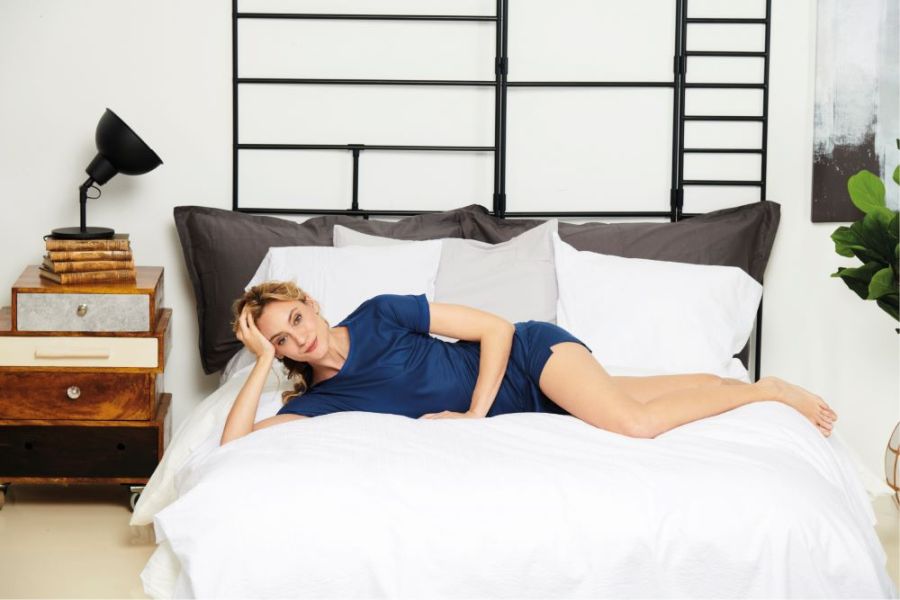
7. Choose cooling sleepwear to naturally reduce night sweats
As well as addressing your bedding, have a look at what clothes you’re sleeping in. While regular pyjamas might have cut it in the past, now you may need fabrics more tailored to menopausal women.
Best cooling sleepwear for menopause night sweats: Stay cool and comfortable with Dagsmejan NATTCOOL SLEEP TECH Pyjamas (from £79.90). Available in a variety of styles and colours, NATTCOOL material is eight times more breathable, and releases water vapour 60 per cent more efficiently than cotton, cooling you down and keeping you drier with exceptional moisture-wicking abilities.
8. Add ice to your bed to cool the temperature
For a restful night, the optimum temperature for your bedroom is 16-18 degrees C. However, to alleviate night sweats you may want to try lower. ‘I recommend taking this down to as low as 12 degrees C,’ says Hope, who recommends putting ice into a hot water bottle or two and placing them into your bed to lower the temperature before you get in.
9. Time to try a dohar?
Virtually unknown in Europe, traditional dohars were the reserve of the Maharajahs in India, who used them to keep cool during hot nights. Their design comprises three layers of superior-quality, super-soft, finely woven cotton that are not only breathable, but regulate your body temperature as the layers of voile cotton trap cool air in the summer months, while keeping you snug yet not overheated come winter.
Now the dohar is making sleep waves over here…especially among those who are looking for natural remedies to reduce menopause night sweats. ‘Dohars were used for centuries during the hottest nights of the year before the arrival of air conditioning systems in India,’ says Angel Skillman, Shades of Cool London founder.
‘The soft blankets help to ward off the unpleasant feeling of waking sweaty and hot from night sweats, yet they feel weighty, making them cosy and comfy, without the extra heat you’d get with a normal duvet,’ says Angel.
What’s more, dohars become more comfortable and softer over time. ‘Each time they’re washed and then line dried or popped into a tumble dryer on a low heat, the natural fibres become twisted, pulled and bent, which serves to make them feel softer and even cosier,’ says Angel.
Dohars for menopause night sweats: Shades of Cool London Traditional Sleep Dohars (from £135) are made from 100 per cent hypoallergenic, sustainable cotton, printed with azo-free dyes and shipped in plastic-free biodegradable packaging. Handcrafted by artisans in Jaipur, India, for every purchase, £1 is donated to The Pink Rickshaw Company in Jaipur, which provides employment to 200 women from low-income households.
Related: Best menopause supplements and herbal remedies UK
Words: Alison Hardinge | Images: Shutterstock

